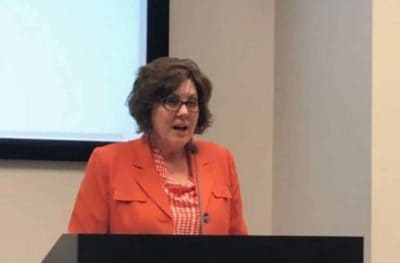

In a daylong planning session on Monday, the Rowan-Salisbury School Board granted a reprieve to North Rowan High School, which was being considered for demolition.
The school, built in 1958, boasts a passionate and vocal support community. When the district held information meetings around the county in December, the North district was particularly outspoken in their support of the school. The board voted unanimously Monday not to discuss demolition further until redistricting plans have been developed and implemented. This process is expected to take 18 months to two years.
North Rowan High School is only one of many schools in Rowan-Salisbury that could shut down. Capital and operational funding are inadequate to keep the district’s aging buildings in habitable condition, and the system presented a plan in December to close multiple elementary, middle, and high schools — and build some new schools to replace them.
Michael Miller of Numerix LLC in Charleston, SC, was engaged to provide possible options to the board in considering different scenarios of closures and redistricting.
At risk of closure under the plan are three elementary schools in the eastern part of Rowan County: Faith Elementary, Granite Quarry Elementary, and Rockwell Elementary. A new school would be built to replace them. Koontz Elementary, built in 2003, is being considered for repurpose into a high school Career Technical Education facility. Overton Elementary School, built in 1964, is planned for demolition. Knox Middle School, next door to Overton and built in 1966, would also be demolished under the plan, and a new K-8 school would be built to replace both schools. Under one scenario, the K-8 school would be built near Salisbury High School to replicate “purpose-built” schools. The board has shown interest in this model, particularly East Lake School in Atlanta.
Two middle schools in the southern part of the county, Corriher-Lipe and China Grove, would be closed, and a new South Middle School would be constructed.
Also in the southern part of the county, Enochville Elementary, China Grove Elementary, and Landis Elementary schools would be closed. These schools were built in 1936, 1924, and 1952, respectively. To accommodate the students, additional classrooms would be added at Millbridge and Knollwood Elementary schools and a new South Elementary School would be constructed.
Salisbury High, built in 1936, in the central part of the county would remain for the next five to 15 years but could be demolished in the third stage of the plan. Significant private money has been spent on renovations to the school in the last decade, including computer labs, sports fields, and tennis courts and practice fields. The historic auditorium just underwent a multi-million dollar face lift. A new athletic complex will be built next year after a successful capital campaign raised millions for the project. In discussion on Monday, however, the board talked about closing Salisbury High earlier than proposed and redistributing students among the other high schools.
Miller presented a number of scenarios for redistricting with proximity to homes being a key priority. The board took a half day to review the scenarios. They identified more combinations they’d like to see and asked Miller to present them at their work session on Feb. 11.
The board spent the second half of the day reviewing the consolidation plan and trying to make it even more financially effective.
One example of a new approach was their outlook on Henderson Independent School. Students attending Henderson had challenges in a more traditional school environment. Housed in the former Henderson Elementary School built in 1917, the school has 80 students inside 33,000 square feet. Demolition of the building was identified in the consolidation plan because the school has $2.6 million in capital needs. The plan suggested buying two eight-classroom pods and installing them on land the district already owns on Heilig Road. In addition to the expense of the pods, paving and curbing would be necessary, bringing the total cost to $4 million.
Board chair Josh Wagner disagreed with the plan. “A pod at best is temporary. If the existing building needs $2.6 million, why spend $4 million for a temporary solution?”
Henderson School is listed as a contributing structure in the North Main Historic District. A city planner for Salisbury said, “A demolition would have to go to the Historic Preservation Commission for approval. Under state law, the HPC would have the ability to delay it for 365 days.”
The board discussed placing the independent high school in the building with an existing high school. School principal Alexis Cowan was present, and the board asked his opinion.
“Knowing the needs of our students at Henderson,” he said, “the pods may be adequate. Knowing the abuse, the mental issues, the difficulties, we often have need of separate spaces where students can be pulled out with a mentor or counselor. I like the concept of walking trails and using nature, but I want to speak in favor of our students and their needs. We must give them some hope. They may come to us from a group home or a different facility …. Knowing what I know in this short period of time with at-risk students — and I mean extreme at-risk, through no fault of their own — we must provide for them.”
“In order to have a restorative mindset, acceptance is what our students are about. Putting them in another high school is not practical,” Cowan said. “Many want to return to their original high schools. This makes that seem even further away. They may not be accepted at another high school. That school would have to accept our students for what they are. If we can change that trajectory, I would be open to dialogue. But with what I know now, I would not think it is optimal.”
The board asked Cowan to make a presentation at their work session on Feb. 11.
The board also had a lengthy discussion on building a CTE — Career Technical Education — facility. Original plans slated a CTE facility to be retrofitted into the existing Koontz Elementary School, which was built in 2005, and the board seemed to think it impractical to rebuild a school scaled for smaller people into a high school facility.
Another concept was to locate a CTE school in North High School rather than demolish it, an idea originated by Jim Gobbel, mayor of the town of Spencer. Gobbel spoke to the school board in December and noted the negative economic impact closure of the school would have on his town. He asked them to consider locating the CTE school on the property.
The board asked administration to bring data to a school board meeting, including where to locate a CTE school, what tracks to include at the onset, and why. They also requested total cost and cost by track. Board chair Josh Wagner spoke to a time frame on the presentation. “We’re not going to rush it, but we would like it in 30-ish days,” he said.
The board, however, was unified in their commitment to the project. They passed a resolution unanimously to pursue a CTE school regardless of location.
Finally, the board discussed Knox Middle School. The current building, built in 1958, has 54 exterior doors. Many in the community consider it a security risk. Two locations were considered. One concept is to build a new Knox on its existing football field while students attend school in the original building. Once the new building is complete, new students would move in and the original building would be demolished. The other concept is to build near the high school for a “purpose-built” layout. Although the board did not make a decision on Knox, they did state their commitment to building a new school. The board voted 4-3 to extend exploration of Knox to June 30.
“We won’t have access to money to build new schools for three years or so,” Wagner said. “But we’ve got to get our schools balanced in the near future. This is not fun. There are sports teams, students who want to be at this school or that one, but bottom line we need to more equitably redistribute our students — it’s got to be done.”
“It’s been needing done for a long time, and it’s up to us to do it,” Wagner continued. “We can’t kick the can down the road any longer. Folks may ask us, why are you doing all this at one time? The answer is that it all needs done now. If it takes three years to implement, that’s fine, but it’s incumbent upon us to make the tough decisions now.”
The board asked Miller to bring data to them on several concepts:
- Closing Koontz Elementary and retrofitting it as a CTE school
- Closing Overton Elementary and redistributing students among existing elementary schools
- Looking at building East Elementary but closing two of the three elementary schools
- Avoiding building a new wing on Shive Elementary School if only two elementary schools are closed
- Closing Overton, Koontz, and Faith Elementary schools and not building any new schools to replace them.


